Mobile Connect Android
SonicWALL Mobile Connect for AndroidTM is an app that enables Android devices to establish secure, mobile connections to private networks protected by Dell SonicWALL security appliances.
Modern business practices increasingly require that users be able to access any network resource (files, internal websites, and so on.), anytime, anywhere. At the same time, ensuring the security of these resources is a constant struggle. While most users are aware that they must take care to protect computers from network security risks, this security awareness does not always extend to mobile devices. And yet, mobile devices are increasingly subject to security attacks. Furthermore, mobile devices often use insecure, untrusted, public Wi-Fi hotspots to connect to the Internet. It is therefore a challenge to provide secure, mobile access while still guarding against the inherent security risks of using mobile devices.
The SonicWALL Mobile Connect app for Android devices provides secure, mobile access to sensitive network resources. Mobile Connect establishes a Secure Socket Layer Virtual Private Network (SSL VPN) connection to private networks that are protected by Dell SonicWALL security appliances. All traffic to and from the private network is securely transmitted over the SSL VPN tunnel.
To get started with SonicWALL Mobile Connect:
1. Install SonicWALL Mobile Connect from the Google Play Store or the Amazon Appstore.
2. Enter connection information (server name, username, password, and so on).
3. Initiate a connection to the network.
4. Mobile Connect establishes a SSL VPN tunnel to the Dell SonicWALL security appliance.
5. You can now access resources on the private network. All traffic to and from the private network is securely transmitted over the SSL VPN tunnel.
Application Access Control – Support for the Application Access Control feature in Dell Secure Mobile Access 11.0 on E-Class SRA appliances is added in Mobile Connect 3.1. Application Access Control enables Per-App VPN for Android devices allowing administrators to control which applications can access the VPN and, therefore, specific resources on the corporate network. Application Access Control allows remote access administrators to control exactly which resources on the corporate network each application (app) can access. Meanwhile, the device owner can still use their personal Android device for their own activities such as personal email, financial data, pictures, music, accessing third party web sites, and so on.
For more information, see App Access Control.
Personal Device Authorization – Mobile Connect 3.1 supports the Personal Device Authorization feature in Dell Secure Mobile Access 11.0 on E-Class SRA appliances.
Administrators can configure the E-Class SRA appliance so that users who log in with personal devices are allowed access to the network, provided that the user authorizes the device.
Personal Device Authorization is configured independently of Application Access Control and the two features are not required to be simultaneously enabled.
During the authorization process of the personal device:
• An authorization record is created that associates the device with the user.
• The user must agree to comply with corporate policies regarding access of company data and resources from their personal device.
• The company discloses any privacy ramifications to the user, such as that data from their personal device may be sent to the corporation.
Firewall and SRA Appliance Connections
E-Class SRA / Dell SMA Appliances Connection
Connect to Mobile Connect Server
Firewall and SRA Appliance Connections
1. Launch SonicWALL Mobile Connect. You will be presented with the screen to begin your first connection. Tap Add connection.
– Name: Enter a descriptive name for the connection.
– Server: Enter the URL or IP address of the server.
2. Tap Next, Done, Finished, or Save (depending on version used). Mobile Connect will then attempt to contact the Dell SonicWALL appliance.
If the attempt fails, a warning message will display, asking if you want to save the connection. Verify that the server address or URL is spelled correctly, and then tap Save.
If Mobile Connect successfully contacts the server, you will be prompted to enter your Username and Password (unless the server does not require this information).
The Domain field is auto-populated with the default domain from the server. To select a different domain, tap Domain to display a drop-down menu of the available options and tap Save.
E-Class SRA Appliances Connection
In addition to full IPv4 support, VPN connections can also connect to SRA EX appliances through IPv6. This feature requires 10.7.x E-Class SRA firmware or higher.
To connect to an E-Class SRA server:
1. Launch Mobile Connect. You will be presented with the screen to begin your first connection. Tap Add connection.
– Name: Enter a descriptive name for the connection.
– Server: Enter the URL or IP address of the server.
Tap Next, Done, Finished, or Save (depending on version used). Mobile Connect will then attempt to contact the Dell SonicWALL appliance. If the attempt fails, a warning message will display, asking if you want to save the connection.
Before tapping Save, verify that the server address or URL is spelled correctly.
If Mobile Connect successfully contacts the server, the connection will be automatically saved.
The process of connecting Mobile Connect to SonicWALL appliances varies slightly depending on the types of appliances you are connecting. The following sections describe how to connect various appliances:
• Connecting to Dell SonicWALL Firewall and SRA Appliances
• Connecting to Dell SonicWALL E-Class SRA / Dell SMA Appliances
Connecting to Dell SonicWALL Firewall and SRA Appliances
Connect to Mobile Connect Server
After you save a new connection, the list of all configured connections displays.
To establish a Mobile Connect session, perform the following tasks:
1. Tap the connection in the list that you want to initiate. The Connection Status page displays. Tap the VPN ON/OFF switch.
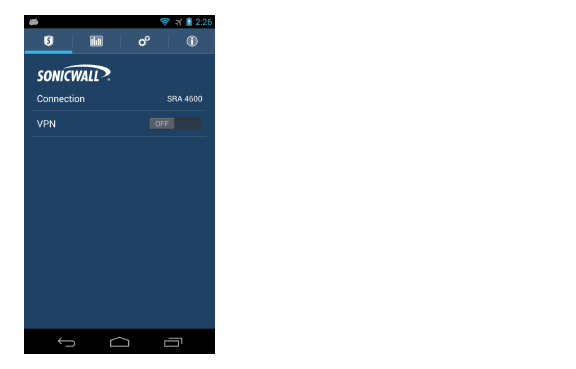
The first time you initiate a connection, a warning message displays. Tap the I trust this application checkbox, and then tap OK.
When the connection is successfully established, the Status changes to Connected and the VPN switch remains in the ON position.
Any bookmarks defined for the portal are displayed below the Status line, and allow you to navigate directly to the bookmark’s destination. Bookmarks will only appear after a VPN connection is established if the server is running firmware that supports Mobile Connect bookmarks and bookmarks have been defined for that user.
Press the Home button to return to your device’s home screen. You can now navigate to other apps to access your Intranet network. The status bar will display a VPN icon ![]() to indicate that the session is still connected.
to indicate that the session is still connected.
If the VPN connection is interrupted, the VPN icon will disappear and you will no longer be able to access the Intranet network. This can happen if your device’s connection transitions to a different network connection (for example, from Wi-Fi to cellular).
Return to Mobile Connect to reestablish the connection. Optionally, you can configure the Automatic Reconnect option on the Settings tab to have Mobile Connect automatically attempt to reestablish interrupted connections.
Connecting to Dell SonicWALL E-Class SRA Appliances
Connect to E-Class SRA Mobile Connect Server
After saving a new E-Class SRA connection, the list of all configured connections displays. (See SRA EX Virtual Appliance and SRA EX9000 in the following figure).
To establish a Mobile Connect session, perform the following tasks:
1. Tap the E-Class SRA connection in the list that you want to initiate. The Connection Status page displays. Tap the VPN ON/OFF switch.
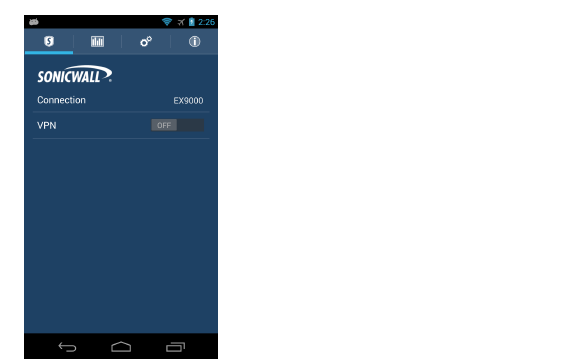
The first time you initiate a connection, a warning message displays. Tap the I trust this application checkbox, and then tap OK.
If Mobile Connect successfully contacts the server, you will be prompted to select which Login Group on the appliance you want to connect to. If you do not know which Login Group to connect to, contact your network administrator.
If the Login Group you connect to is not listed, select Other... to manually type in the group name.
Enter your username and password if prompted (depending on whether the Dell SonicWALL appliance you are connecting to allows for saving usernames and passwords).
If this is the first time you have connected to an E-Class SRA server with Personal Device Authorization enabled, you are prompted to register your device. A similar prompt appears when the terms and conditions have changed. To continue, tap Accept to agree to the terms and conditions.
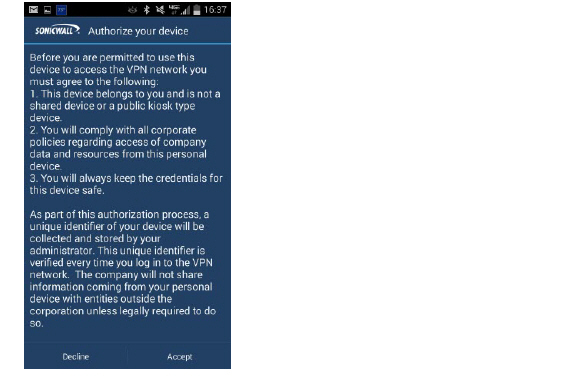
7. When connecting to an E-Class SRA server with Application Access Control configured, a notification about Data Privacy with a list of the applications under control is displayed. Optionally, uncheck any of the displayed apps if you are only using them for personal use and you do not want their traffic sent to the corporate network. Then tap Accept to accept the terms and continue.
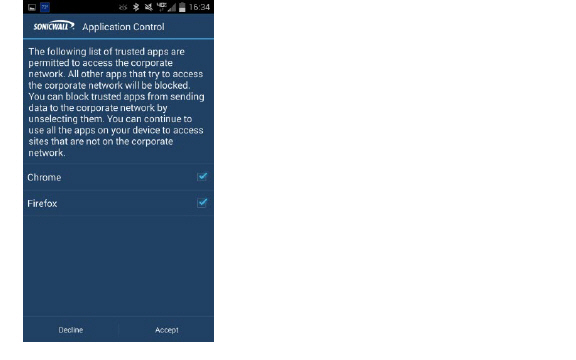
When the connection is successfully established, the Status changes to Connected and the VPN switch remains in the ON position.
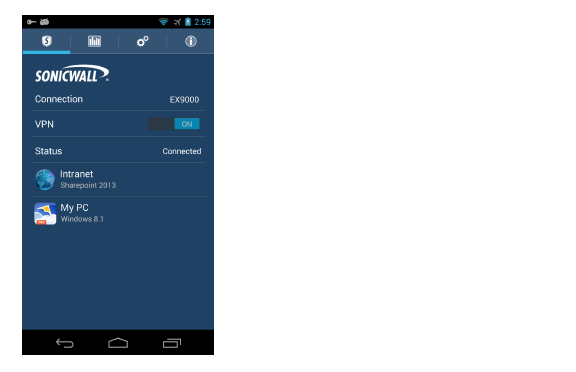
Any bookmarks defined for the portal are displayed below the Status line, and allow you to navigate directly to the bookmark’s destination. Bookmarks only appear after a VPN connection is established and when the server is running firmware that supports Mobile Connect bookmarks and bookmarks have been defined for that user.
If Application Access Control is configured on the server, the list of Bookmarks is replaced by a list of apps that are allowed to access the corporate network.
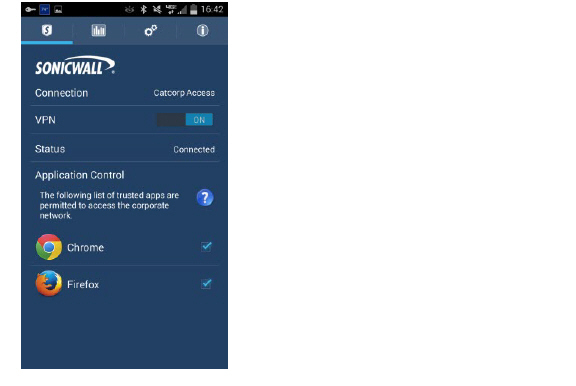
Press the Home button to return to your device’s home screen. You can now navigate to other apps to access your Intranet network. The status bar will display a VPN icon ![]() to indicate that the session is still connected.
to indicate that the session is still connected.
If the VPN connection is interrupted, the VPN icon will disappear and you will no longer be able to access the Intranet network. This can happen if your device’s connection transitions to a different network connection (for example, from Wi-Fi to cellular).
Return to Mobile Connect to reestablish the connection. Optionally, you can configure the Automatic Reconnect option on the Settings tab to have Mobile Connect automatically attempt to reestablish interrupted connections.
SonicWALL Mobile Connect provides several settings for connection and logging options. The Settings tab also provides Support information, which includes a User Guide and device, connection, and server information.
The following options are controlled from the Settings tab:
• Connect on Launch - Sets Mobile Connect to automatically initiate a connection to the last-used profile when it is launched.
• Automatic Reconnect - Sets Mobile Connect to automatically attempt to reconnect if the connection is lost. The SSL VPN connection can be disrupted when your device’s connection transitions to a different network type (for example, from Wi-Fi to 3G). This setting lets applications rely on a sustained VPN connection. There is no limit on the amount of time it takes to reconnect.
• URL Control - Allows other mobile applications to pass action requests using special URLs to Mobile Connect. These action requests can create VPN connection entries and connect or disconnect VPN connections. For example, another application can launch Mobile Connect, access internal resources as needed, and then disconnect by using the mobileconnect:// or sonicwallmobileconnect:// URL scheme. Some common examples of URL Control are:
Add profile: mobileconnect://addprofile[/]?name=ConnectionName&server=ServerAddress[&Parameter1=Value&Parameter2=Value...]
Connect: mobileconnect://connect[/]?[name=ConnectionName|server=ServerAddress][&Parameter1=Value&Parameter2=Value...]
Disconnect: mobileconnect://disconnect[/]
See the Mobile Connect User Guide for full URL Control parameter details.
Bookmarks - Displays centrally configured shortcuts (called bookmarks) to VPN resources like web pages, Remote Desktop servers, files, and terminal servers. These bookmarks, which are displayed on the main Connection tab when the VPN is connected, provide one-touch access to frequently used applications.
If using an SRA appliance, pulling down the Connection screen and releasing it refreshes the bookmarks. Mobile Connect supports Remote Desktop options like screen size and enable/disable audio as long as both the server bookmark and third party application support the option.
Note Bookmarks are supported on most Dell SonicWALL appliances running versions 7.0 or higher with SRA-SMB, 10.6 or higher with SRA-EX series and 5.9.0.2_107o or higher with SonicOS. SonicOS only supports bookmarks when using RDP-Java, VNC, Telnet, or SSHv2 on Mobile Connect.
More About Bookmarks
Files > Delete Cached Files - Deletes all cached files that have been downloaded and stored on the device. Note that cached files are stored encrypted on the device for added security.
Note Files are supported on SRA appliances only when running 7.5 or higher and not supported on appliances running SonicOS.
More About Files Bookmarks
• Logs > Debug Logging - Enables full debug log messages of Mobile Connect activity. Leave this setting disabled unless instructed to enable it by Dell SonicWALL Support staff.
• Logs > Clear Logs - Deletes all log files saved on the device.
The Support section of the Settings tab provides the following support information:
• User Guide - Displays the SonicWALL Mobile Connect User Guide.
• Device Information - Displays information about the device, Wi-Fi connection, Cellular connection, and DNS servers.
• Email Logs - Creates an email to send the Mobile Connect log to Dell SonicWALL Support staff. Tap Send to send the email.
Connections to Dell SonicWALL E-Class SRA appliances have two additional options that are available on the Edit Connection window. To view this option, go to the Connection tab and tap and hold on the Connection line to bring up the Edit Connection window.
The following options can be configured:
• Remember Credentials - Enables saving of user authentication credentials for the VPN connection. This is enabled by default and can be controlled by the E-Series SRA server setting. This feature requires E-Class SRA 10.7.x firmware.
• Forget Selections - Mobile Connect remembers the Login Group that you specified when configuring the connections. To change to a different Login Group, tap Forget Selections. The next time you connect to the server, you will be prompted to select a new Login Group.
Note If this option is not displayed, you are connecting to either a Dell SonicWALL firewall or SRA appliance.
|
|
|
|
|
|
|
|
http://server/example%20file.html
mobileconnect://connect?callbackurl=http%3A%2F%2Fserver%2Fexample%2520file.html
When there are more than five bookmarks, the bookmarks are replaced by a Filter screen that groups bookmarks by type. Select the type of bookmarks to display or select All Bookmarks to display all bookmarks.
When connected to an SMB SRA server, SRA 7.0 or higher is required for Bookmarks support.
Note When connected to a Dell Secure Mobile Access appliance with Application Access Control enabled, the Bookmarks list is replaced by a list of trusted apps that can access the corporate network.
Selecting a bookmark for an app that is not installed will prompt you to install the app. Apps referenced by bookmarks also can be installed at any time using the Settings > Bookmarks tab. In addition to installing apps for bookmarks, the Settings > Bookmarks tab is also used to select and install apps for bookmarks that support multiple third party apps. For example, you might select Chrome or Firefox for a Web bookmark.
Mobile Connect supports the following types of bookmarks and associated apps.
Desktop Bookmarks:
Portal name: Terminal Services (RDP – ActiveX), Terminal Services (RDP – Java) Internal type: RDP5ActiveX, RDP5Java
RDP bookmark types attempt to launch with the associated RDP application, as configured in the Settings tab.
|
Additional details such as screen resolution should be provided to the client. However, support for passing such parameters will vary based on the application. For example:
• Wyse PocketCloud Pro does not support the “connect to console” option
Portal name: Virtual Network Computing (VNC)
Internal type: VNC
VNC bookmark types attempt to launch with the associated VNC application as configured in the Settings tab.
|
Additional details such as screen resolution should be provided to the client. However, support for passing such parameters varies based on the application.
Portal name: Citrix Portal (Citrix)
Internal type: Citrix, Citrix_https
Citrix bookmark types will attempt to launch with the associated Citrix application.
|
Additional details such as screen resolution should be provided to the client. However, support for passing such parameters will very based on the application.
Web Bookmarks:
Portal name: Web (HTTP), Secure Web (HTTPS), External Web Site
Internal type: HTTP, HTTPS, URL, URL_https
These bookmarks will launch in an associated web browser and the provided ‘Name or IP Address’ (HostID) will be passed as the parameter to display in the browser.
|
Portal name: Mobile Connect
Internal type: MC
The Mobile Connect bookmark type will rely on the operating system to determine and launch the proper application. The bookmark is expected to be properly configured for launch. The Mobile Connect app will attempt to launch it as is. (for example, telnet://server)
Terminal Bookmarks:
Portal name: Telnet, Secure Shell Version 1 (SSHv1), Secure Shell Version 2 (SSHv2)
Internal type: Telnet, SSH, SSHv1
|
ConnectBot notes: Proper formatting is required for ConnectBot SSH (server bookmark field requires username@server).
Note Some supported third party apps may not yet be available in the Amazon Appstore.
Mobile Connect 3.0 introduced secure mobile access to files through Files bookmarks. Files bookmarks are displayed after the VPN is connected in the table of bookmarks. Tapping a Files bookmark allows secure access to files by first checking and enforcing the server-configured file policy, and then securely downloading and displaying the file within the Mobile Connect app.
Granular policy controls can be configured to allow other Android apps to use each file. On Android, policies include control over whether a file may be opened in a third-party app or securely cached on the device. Files bookmarks can also be created to folders or file share root directories to allow directory navigation.
Note Beginning in Mobile Connect for Android 3.0, Files bookmarks are supported on the Dell SonicWALL SRA appliances starting with SRA 7.5 firmware. Support for Files bookmarks in Dell Secure Mobile Access and Next Generation Firewalls is expected in a future release.
When Files bookmarks are configured for the user on the server appliance, they appear in the list of bookmarks after the VPN is established and can be filtered by selecting the Showing: Files row that is displayed when there are more than five bookmarks.
Tapping a Files bookmark queries and enforces the server-configured file policy for that file bookmark. If the file is not already cached on the device, it securely downloads the file from the SRA appliance. Once the file is downloaded, it is opened in the Android default file viewer app for that file type.
Tapping a Files bookmark to a folder or directory allows for directory browsing and file download and viewing of any file in the folder. All attempts to browse a file folder or view a file query the server to enforce access policies. On Android, the default file viewer app is automatically launched after a file is downloaded.
Supported File Types
Mobile Connect supports all file types natively supported by Android, including the following:
|
Unsupported Files
If a file type is not supported, the user will be prompted that the file may not be viewable unless there is another app installed that can view the file. The user can tap ‘Try Anyway’ and if there is another app that is registered to handle that file type, the user will have the option to open the file in that app.
File Policies
On Android, server-configured policies control whether a file can be opened in a third-party app or securely cached on the device.
For example, if a file has the Allow Open In policy disabled, the file cannot be viewed on an Android device. Mobile Connect launches third-party apps to view all file types, so the Allow Open in policy must be enabled to view a file.
Mobile Connect 3.1 supports the Application Access Control feature in Dell Secure Mobile Access 11.0 and higher on E-Class SRA appliances. Application Access Control allows remote access administrators to control exactly which resources on the corporate network each application (app) can access. Meanwhile, the device owner can still use their personal Android device for their own activities such as personal email, financial data, pictures, music, accessing third party web sites, and so on.
If the E-Class SRA administrator has configured this feature, you will log in to a Login Group that allows a list of trusted apps to access corporate resources. The specific version of each app is included in the configuration. The Application Access Control rule list controls:
• Which applications can send data through the VPN tunnel
• Which destinations on the corporate network those applications are allowed to access
The first time you connect and log in, you must agree to the displayed terms and conditions.
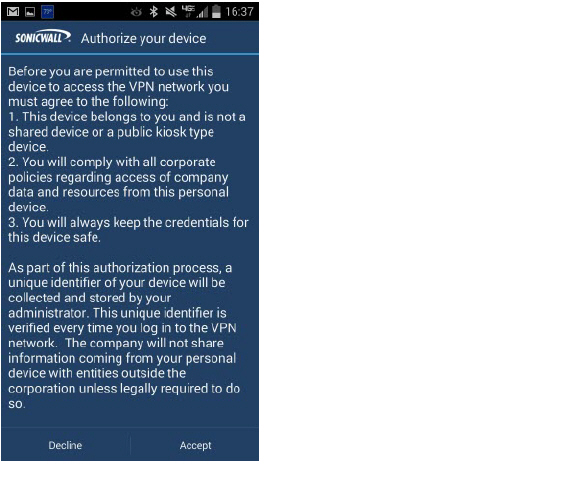
Your device is then registered with the server, and will be recognized in later connections. If the policy or list of trusted apps changes, you will be asked to re-accept the terms and conditions.
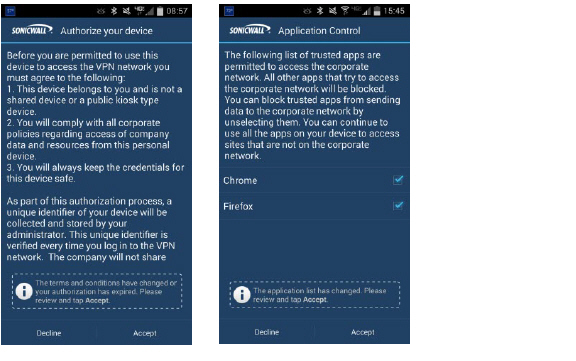
Multiple personal devices can be authorized for a single user, and a single personal device may be registered by multiple users.
The list of trusted apps is displayed on your device after you agree to the above terms. You can block trusted apps from sending data to the corporate network by clearing the checkbox for them on your device. Typically, you would uncheck any application that is only being used for personal tasks or information, to prevent the app from sending any traffic to the corporate network. Tapping Accept continues with the connection.
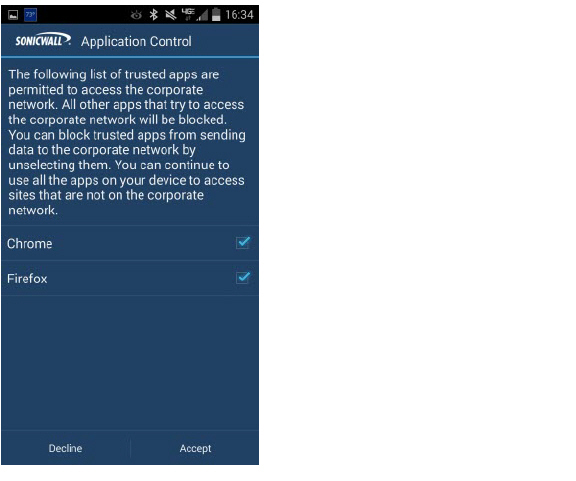
The device is now fully connected to the E-Class SRA server.
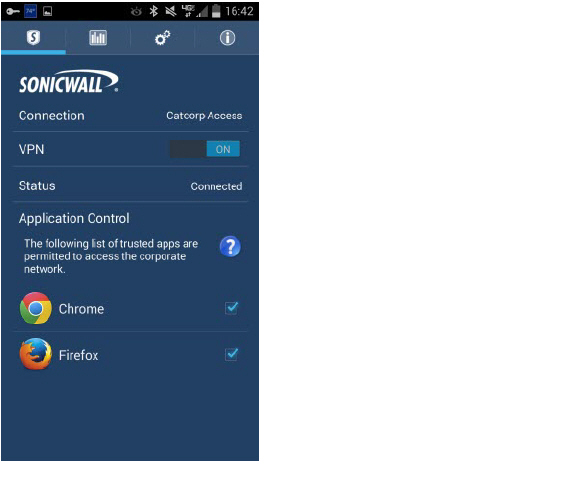
To request that additional apps be added to the trusted apps list, contact the E-Class SRA appliance administrator.
If your device has an app installed that is not the same version as the one approved on the server, or if an approved app is not installed on your device, the app name is displayed without a check mark. Instead, a red circle “no” symbol is displayed next to it.
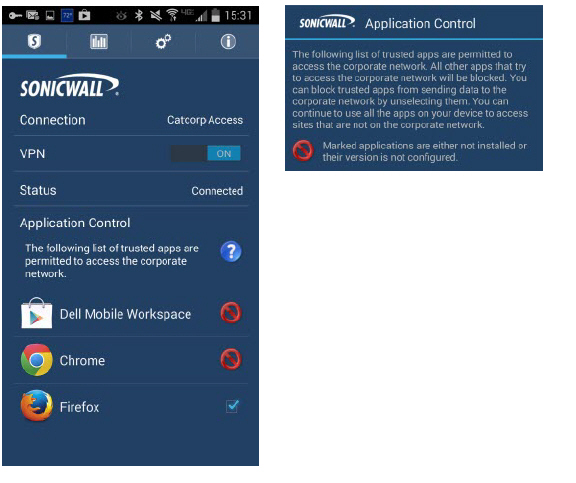
When connected to an E-Class SRA server running Dell Secure Mobile Access 11.0 or higher with Application Access Control configured, device traffic is handled in four ways:
1. For applications listed and selected in the application list, traffic destined for the corporate network from those applications is allowed to enter the VPN tunnel. The application ID and signature are used by the server to identify the application.
2. For applications that are on that list and are not selected (or any other application on the device), traffic destined for the corporate network is blocked and/or dropped by Mobile Connect and does NOT enter the tunnel.
3. All applications (regardless of whether or not they are on the application list) send traffic out the default interface of the device if the traffic is NOT destined for the corporate network.
4. The information status symbol “i” displays on applications that are “learned” by the appliance but still have at least one version pending approval.
About Learning Mode (Administrators Only)
Designated administrators can use Android devices as trusted learning devices when working with E-Class SRA appliances running SMA 11.0 and higher (with Application Access Control enabled). A trusted learning device is assigned special privileges to perform signature lookups as a part of learning application version information. When the trusted learning device is connected to the E-Class SRA server, apps that need versions to be learned are displayed. After launching the app, a  Pending Approval icon displays next to the app name. The app can then be approved by the E-Class SRA administrator.
Pending Approval icon displays next to the app name. The app can then be approved by the E-Class SRA administrator.
For more information about configuring Application Access Control on the E-Class SRA appliance running SMA 11.0 and higher, see the Dell Secure Mobile Access Application Access Control Feature Guide.
Note Client certificate support is only available for connections to Dell SonicWALL E-Class SRA , Dell Secure Mobile Access, and SMB SRA appliances.
Configuring Client Certificates with E-Class SRA Appliances
If a client certificate is required during authentication, you are automatically prompted to select a client certificate from the Android device client certificate store.
Select the client certificate from the list of certificates and tap Allow.
By default a VPN configuration prompts you to select the client certificate during authentication. If you successfully authenticate with a client certificate, the VPN configuration profile is automatically updated to use the client certificate for each subsequent connection attempt. To reset the client certificate selection, edit the connection and tap the Forget Selections button.
Note If no client certificates are installed, an Android No certificates found dialog appears with an option to install a PKCS#12 file located in external storage.
Configuring Client Certificates with SMB SRA Appliances
On Dell SonicWALL SMB SRA appliances, client certificate authentication is available as a second factor authentication method in addition to standard user name and password authentication. If a client certificate is required during authentication, you are automatically prompted to select a client certificate from the Android device client certificate store.
Select the client certificate from the list of certificates and tap Allow.
By default the client certificate is set to Choose during login for a VPN configuration. If you successfully authenticate with a client certificate, the VPN configuration profile is automatically updated to set the client certificate to the one that was chosen. To reset the client certificate selection, edit the connection and set the Client Certificate field back to Choose during login.
Note If no client certificates are installed, an Android No certificates found dialog appears with an option to install a PKCS#12 file located in external storage.
The Monitor tab displays additional details about the connection, statistics on traffic transmitted, DNS information, and routes that have been installed. The compression ratio is shown when connected to an appliance running SRA 7.5 or higher with compression enabled. Traffic over the VPN tunnel is compressed using the LZ4 algorithm.
The About tab of SonicWALL Mobile Connect displays the version number and legal text.
When a Mobile Connect session is active, the Android System Notifications area includes an entry indicating that the VPN is connected.
Tapping on the SonicWALL Mobile Connect entry in the Android System Notifications area displays a summary of statistics on the VPN session. The statistics page displays the server name, duration of the session, and the amount of traffic that has been sent and received. Three buttons are also provided on this screen:
• Cancel – Closes the statistics screen.
• Disconnect – Disconnects the Mobile Connect session.
• Configure – Launches the SonicWALL Mobile Connect app.
Mobile Connect Widget
When the SonicWALL Mobile Connect app is installed, a widget for Android is also created in the widgets tab. It can then be dragged from the widgets tab to the home screen. This widget is used as follows:
• The widget shows the connection status (connected, disconnected, connecting, and so on.)
• Tap the icon to establish a tunnel when disconnected.
• Tap the icon to disconnect the tunnel when connected.
• Tap any other area of the widget to launch the Mobile Connect client.
This section describes some troubleshooting you can try if you are unable to connect to the Dell SonicWALL server.
Failed End Point Control Check
End Point Control can prevent the connection when the server is an E-Class SRA appliance or an SMB SRA appliance running SRA 7.5 (or higher). During the connection process, the connection status displays “EPC checking...” while the End Point Security policy checks are performed. If the device is not compliant because a security check failed, an error message is then displayed.
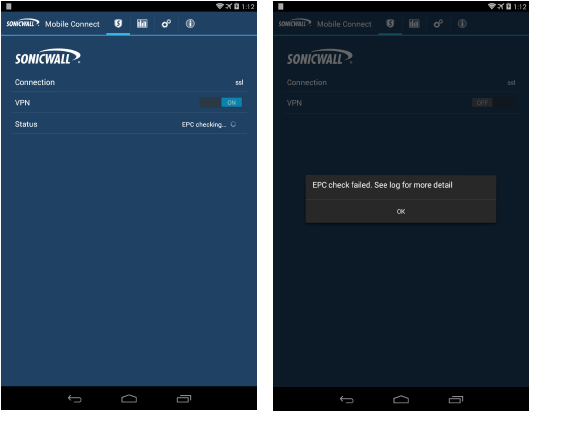
You can view the Mobile Connect log for more detailed information about which check failed. For example, you might see the following if an EPC policy was set up to restrict access to only a single device ID (EQUIPMENT ID).
2014-07-10 13:08:23:974 DEBUG Thread-142 - SraEpcManager - Allow Profile: {AndroidEPCExamplePolicy:[Literal=EQUIPMENTID,1,1234567890]}
2014-07-10 13:08:23:976 DEBUG Thread-142 - SraEpcManager - Deny Profile: {}
2014-07-10 13:08:23:977 DEBUG Thread-142 - SraEpcManager - Recurring Mode: 1
2014-07-10 13:08:23:978 DEBUG Thread-142 - SraEpcManager - Recurring Period: 1
2014-07-10 13:08:24:200 DEBUG Thread-142 - SraEvaluator - Evaluate literal: Literal=EQUIPMENTID,1,1234567890
2014-07-10 13:08:24:200 DEBUG Thread-142 - SraEvaluator - DeviceID<abcda50e-e13b-1234-b89d-b3da7384a2f5>, expect<1234567890>
2014-07-10 13:08:24:201 INFO Thread-142 - SraEpcManager - Failed allow profile:Literal=EQUIPMENTID,1,1234567890
When the server is either an E-Class SRA appliance or an SMB SRA appliance running SRA 7.5 (or higher), policies can be created to check different attributes of the Android device, including:
• Rooted or Not Rooted
• Client certificate installed
• Android OS version
• Device ID / Equipment ID
• Anti-Virus App
• Personal Firewall App
• Application
• Directory name
• File name
See the Administrator Guide for the server for complete information about End Point Control policy options.
If you are unable to connect to the Dell SonicWALL server, perform the following steps to troubleshoot the connection.
1. Double check that you have entered the server name properly in the connection configuration.
2. Go to the web browser on your device and attempt to navigate to the SSL VPN appliance web portal.
3. If you are unable to load the web portal, the problem is with the Dell SonicWALL appliance. Contact your network administrator if the problem persists.
4. If the web portal loads successfully on the browser and you still cannot establish a Mobile Connect connection, notify Dell SonicWALL Support, as follows:
a. On the Settings tab, enable the Debug Logging option.
b. Attempt a connection to the server again to ensure that full debugging messages are logged for the attempt.
c. Then return to the Settings tab and tap the Email Logs button. An email will launch in your mail client with the Mobile Connect log attached. Address the email to Support@sonicwall.com. Add any additional comments to the email and tap Send. Dell SonicWALL Support staff will contact you after reviewing your case.